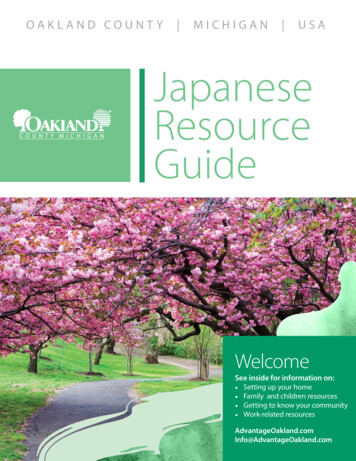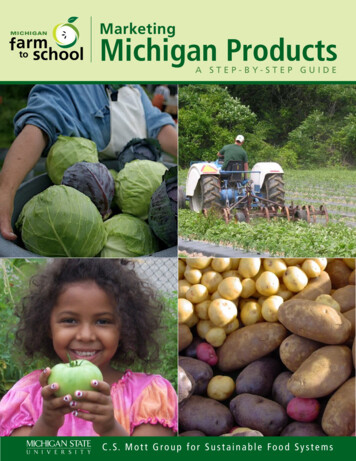
Transcription
Michigan State University C.S. Mott Group for Sustainable Food Systems www.mifarmtoschool.msu.edu2 of 47
Table of ContentsMarketing Michigan Products to Schools: A Step-By-Step GuideStep 1: Get Started.4Step 2: Build Community Connections.5Step 3: Prepare Marketing Packet and Bid Documents.5Step 4: Develop Contract or Agreement with Schools.6Step 5: Begin Selling Your Products to Local Schools.7Preamble: Get Real About Farm to School.8Step 1: Farmer Self-Assessment.10Step 1: Addressing Food Safety.16Step 1: Insurance Considerations.21Step 1: School Food Budgets.23Step 2: Michigan Distributors.26Step 2: Resources to Link with Schools and Farm to School Programs.27Step 3: School Food Service Questionnaire.28Step 3: Pricing for School Meals Programs.33Step 3: Completing Product Availability and Pricing Forms.35Step 3: Sample Product Availability and Pricing Form.37Step 3: Sample Vendor Questionnaire.38Step 3: Sample Evaluation Criteria for Selecting Vendors.40Appendix I – Buying Local: Approved Food Sources for Food Establishments .41Michigan State University C.S. Mott Group for Sustainable Food Systems www.mifarmtoschool.msu.edu3 of 47
Marketing Michigan Products to Schools: A Step-By-Step GuideWelcome to Marketing Michigan Products to Schools: A Step-By-Step Guide.Follow these steps to market your Michigan agricultural products to school foodservice for school meals programs, special events, and/or fundraisers.Communication, flexibility, and understanding risks and benefits are keys tosuccess, and relationships are the heart of farm to school!Step 1: Get Started Determine your interest and ability to market your farm products to schools, andcompile information about your farm, products, and business practices beforeyou talk with local schools about this market opportunity.Tool: Farmer Self-Assessment Food safety is a priority for schools. Prepare a food safety program for your farm,consider getting a GAP (Good Agricultural Practices), GHP (Good HandlingPractices) and/or other third-party audit, and/or complete a food safety self-auditto assure school customers that your products are safe.Tool: Addressing Food Safety Schools typically require food vendors to have product liability insurance toprovide coverage for any food safety issues that may arise with food products.You may want to consider additional insurance types depending upon your farmpractices and needs.Tool: Insurance Considerations Keep good records! Know your costs of production in order to appropriately priceyour products. One good resource is Telfarm, a financial record keeping systemavailable from Michigan State University Extension’s Farm InformationResources Management (FIRM) Team at http://www.canr.msu.edu/telfarm/.Become familiar with school food funding to understand how school food servicedirectors purchase food, including local food. If you would like to learn moreabout School Food Programs and Regulations, see Appendix II.Tool: School Food FundingMichigan State University C.S. Mott Group for Sustainable Food Systems www.mifarmtoschool.msu.edu4 of 47
Step 2: Build Community Connections Find schools in your area, and start to build relationships with food servicedirectors and school community members. Contact local school food servicedirectors to tell them about your products. Meeting with a PTO or PTA is a goodplace to start if you would like to participate in school fundraisers.Contact local distributors with whom you would be willing to work to see if theywould carry your products, if you are interested in wider distribution of yourproducts to schools. Many school food service directors appreciate the ease andfamiliarity of working with distributors.Tool: Michigan Distributors Connect with state or local organizations to link with on-going farm to schoolprojects and/or schools that are interested in initiating farm to school programs.Tool: Resources to link to FtS programs and interested schools Capitalize on your existing networks! Connect with other farmers in your area tosee if you can collaborate with them on production, washing, packaging, storing,and/or delivering local products for school markets. The New North FloridaCooperative is one example of a successful network of farmers working togetherto supply produce to local schools. Learn about their innovative marketingstrategy athttp://smallfarms.ifas.ufl.edu/planning and management/pdf/SuccessNo4.pdf.Step 3: Prepare Marketing Packet and Bid Documents Develop marketing materials and a profile of your farm business to share withprospective school customers. Be sure to distribute business cards as well. Offertaste tests or a harvest basket of your products to school food service directors toassure them of the high quality of your products and/or introduce them to newproducts.Ask questions. Contact prospective school customers during the bid process toget questions answered, determine their flexibility, and begin establishing arelationship. Ask them about products they currently use in school food service inorder to match and market your products’ seasonal availability with typical schoolusage. Let them know if you have additional products that may be of interest, andif you are willing to expand or customize your production to meet their needs.Tool: School food service questionnaireMichigan State University C.S. Mott Group for Sustainable Food Systems www.mifarmtoschool.msu.edu5 of 47
Prepare product availability and pricing forms to help market your products andrespond to requests for quotes or bids from schools. Include seasonal availabilityand pricing for all varieties, sizes, and packs of products you grow and market.Tool: Pricing for school meals programsTool: Completing product availability and pricing formsTool: Sample product availability and pricing sheetTool: Sample vendor questionnaire Gather and include copies of documents pertaining to inspections, certifications,insurance, and/or food safety in your bid packet. If you can, provide contactinformation of other customers who would be willing to offer positive references.Understand how your bid will be evaluated when you respond to schools’requests for quotes or bids. Review typical criteria for evaluating and selectingbids, and describe how your products stack up. Determine which value-addedservices you can offer, like participating in school visits or school fundraisers, andinclude those services in the marketing materials and bids you submit to schools.Tool: Sample evaluation criteria for selecting vendors Submit your bid to prospective customers.Step 4: Develop Contract or Agreement with Schools Invite new customers to tour your farm/business before you begin sellingproducts to them, and ask for a tour of the schools’ food service facilities.Meet face-to-face with school food service directors to determine your mutualneeds prior to establishing an agreement or contract. Be sure to discuss anordering schedule, delivery and packaging requirements, and payment terms.Co-write agreements or contracts with your new school customers. Be sure todiscuss the best methods for maintaining contact (phone, email, or fax) andsharing news about new products or services. You can use a sample invoice inAppendix III as a template for invoicing school customers.Michigan State University C.S. Mott Group for Sustainable Food Systems www.mifarmtoschool.msu.edu6 of 47
Step 5: Begin Selling Your Products to Local Schools Stay in regular touch with school customers to ensure customer satisfaction,maintain a good professional relationship, and notify them of new products orservices.Be proactive, and keep the value-added services coming! Offer to visit schoolclassrooms and cafeterias to do educational programs and/or taste tests withstudents. Offer to host school field trips at your farm. Suggest products that maybe particularly suitable to school fundraisers. Develop clear plans for any of theseopportunities before discussing them with school customers.AppendicesI: “Buying Local – Approved Food Sources for Food Establishments” fromMichigan Department of AgriculturalII: School Food Programs and RegulationsIII: Sample InvoiceMichigan State University C.S. Mott Group for Sustainable Food Systems www.mifarmtoschool.msu.edu7 of 47
Preamble: Get Real About Farm to SchoolThe term “farm to school” applies to a variety of initiatives but centers around efforts tooffer local foods in school cafeterias. Results from a 2004 Michigan Farm-to-SchoolSurvey showed that 73% of the food service directors who responded were interested inpurchasing food directly from a local farmer.1 Preliminary results of a similar surveyshow a dramatic increase in the number of schools and school districts that havepurchased foods directly from Michigan farmers and producers in the 2008-2009 schoolyear.2 As of early 2010, about 60 established farm to school programs have beenidentified statewide but many more programs likely exist. More farmers with a widervariety of products available for more of the school year are needed to meet thisgrowing demand!Local purchasing programs offer a variety of benefits. Farm to school programs may: offer an expanding market opportunity for farmers and a way to diversify marketsand manage risk keep dollars within Michigan communities give school food service directors greater ability to specify their needs and achance to have closer relationships with their food vendors and producers provide school children with better access to local foods, including fresh fruitsand vegetables improve school children’s understanding of local foods and agricultureTo get real about farm to school, you must first get real about your motivation. Schoolbudgets are tight, and food service directors may have constraints that require certainoperating procedures that can make local purchasing challenging. While marketing toschools will not often bring large profits, schools can provide a stable, steady market tobuild into your marketing portfolio. Developing relationships may take some time,patience, and flexibility, but school food service directors are often loyal, long-termcustomers if they find vendors with good service and quality products at competitiveprices. Many farmers enjoy the feel-good nature of farm to school, but prices should stillcover costs so that this can be a long-term, win-win opportunity.The tools in this guide are geared toward school markets, but much of its informationmay be applied to other types of outreach and marketing, including other institutional1Izumi, B.T. et al. (2006) Results from the 2004 Michigan Farm–to-School Survey. Journal of School Health, 76(5):169-174.2Matts, C., Colasanti, K., Hamm, M.W., and Smalley, S.B. (Unpublished data). Survey of K-12 school food serviceproviders in Michigan.Michigan State University C.S. Mott Group for Sustainable Food Systems www.mifarmtoschool.msu.edu8 of 47
markets such as colleges/universities, hospitals, and/or correctional facilities. Thechallenges and constraints that institutional food service programs face are oftensimilar, but there are no one size fits all solutions or strategies for farm to institutionprograms. Programs vary depending upon the location, agricultural production andseasonal availability in the area, and the type, size, equipment, and delivery needs of afood service program. While the guide cannot give you all of the answers, it is designedto prepare you to access school markets and provides questions to ask and getanswered as you embark on this new marketing venture.Michigan State University C.S. Mott Group for Sustainable Food Systems www.mifarmtoschool.msu.edu9 of 47
Step 1: Get Started - Farmer Self-AssessmentThe following questions are designed to help you determine your interest and ability tomarket your food products to local schools. This information is not necessarily forsharing with schools but is essential for you to know and will be helpful when you begintalking with school food service directors and/or distributors about supplying food tolocal schools and/or school districts.1. Farm Business and DescriptionHave your contact and basic farm information available in writing when you beginconversations with school food service directors, including:a. Your name and farm/business name, address, phone number, fax number,email address, and website, if applicable; a business card with thisinformation is helpfulb. What are your months of operation for production, and for marketing?c. What days and hours is your farm business open?d. What days and hours are you available?Farm Descriptione. What size is your farm? How many acres are in production? Would you bewilling to expand production to additional acreage? Would you be willing orable to adjust your crop mix on your current acreage?f. What are your full costs of production per acre, and per crop, including alllabor? What is the minimum amount in profit per crop you need to continue togrow that crop?g. Farm Products and Productioni. School food service directors are often most interested in fruits andvegetables for school meals programs, but some schools are alsointerested in purchasing specialty products for special events. Otherfarm products like apples, flowers, honey, maple syrup or pumpkinsare good for school fundraisers. What types of products do yougrow/raise? Fruits Vegetables Meats Dairy EggsMichigan State University C.S. Mott Group for Sustainable Food Systems www.mifarmtoschool.msu.edu10 of 47
Specialty ProductsHerbsPlants, treesFlowersFiber Productsii.If you grow fruits and/or vegetables, please note which ones in thechart below. Which products might you be willing and able to grow andsell, if schools express interest? Remember, flexibility is key.VegetableAsparagusBeetsBroccoliBrussel sGreen BeansGreens (collards, kale, etc.)EggplantLettuce (Romaine, Bibb, shesSalad GreensSpinachSquash, summer(yellow, zucchini)Squash, winter(butternut, acorn, etc.)Currently Grow and Sell Willing to Grow and Sell Michigan State University C.S. Mott Group for Sustainable Food Systems www.mifarmtoschool.msu.edu11 of 47
Tomatoes (cherry, slicing, bStrawberriesWatermelonOther: Currently Grow and Sell Willing to Grow and Sell h. Production practices (Please check all that apply):i. Certified/verified practices Certified organic Certified naturally-grown Good Agricultural Practices (GAP) certified MAEAP (Michigan Agriculture Environmental AssuranceProgram) verifiedii.Other practices Organic GMO-free Integrated pest management Pesticide free Synthetic chemical freeMichigan State University C.S. Mott Group for Sustainable Food Systems www.mifarmtoschool.msu.edu12 of 47
Hormone eri. Pest managementi. Please describe your pest management practices, including integratedpest management.ii.Are you willing to inform school customers of pesticide applications, ifapplicable?j. List annual inspections and certifications your farm/business receives fromUSDA, state, or local inspectors and/or third-party auditors or certifiers, andtheir frequency (annual, bi-annual, etc.). Gather your latest inspection reports,certification documentation, farm plan and/or food safety and sanitation plan.Are you willing to share these inspection and/or certification reports withschool customers?k. Do you have a HACCP (Hazard Analysis and Critical Control Points) plan? Ifso, please describe.l. Do you have an insurance policy that has product liability coverage? What isthe payment limit? If you are willing to host school field trips, does yourinsurance offer liability coverage for your property/premises, often known asgeneral liability?m. Do you have greenhouses and/or hoop houses on your farm for extendedseason production? How does this affect your product availability?n. Do you have post-harvest storage facilities on your farm? If so, for whatproducts? Please describe.o. Are you able to wash and/or pack farm products? If so, note which productscan be washed and packed, and describe if applicable. (Please note thatadditional certifications are required for processing farm products.)2. Salesa. Are you primarily a wholesaler or retailer? To which types of markets do youcurrently sell farm products?Michigan State University C.S. Mott Group for Sustainable Food Systems www.mifarmtoschool.msu.edu13 of 47
b. Who are your current customers?c. What percentage of your total farm sales does each comprise?d. Where are they located? Where and when/how often do you deliver to them?e. Would they be willing and available to serve as references for you?f. Are there other available market outlets near schools to which you can sellyour products?3. Logistics - Ordering, payment, deliverya. How do you prefer customers place orders? By telephone, fax, email orwebsite?b. How often do you prefer customers place orders? Monthly, weekly, or on aspecific day of the week?c. How will products be packaged for school customers? Please describe butnote that this can often be negotiated with school customers.d. Do you have a minimum amount, volume or dollar value for orders and/ordelivery?e. How far are you willing to travel per order and/or delivery? Or would youconsider a delivery fee/charge for customers that require further travel?f. Many school districts require deliveries to multiple school sites. Are youwilling to deliver to more than one location per order?g. How many times per week or per month are you willing to deliver?h. Do you have a refrigerated truck? If not, please describe delivery method.i. Will you allow school customers to pick up products at your farm if they wouldprefer? If so, what are the best days of the week and times for order pick up?j. Can you provide invoices upon delivery, and include a receipt of delivery formto get signed by school customers? (See Sample Invoice in Appendix III.)Michigan State University C.S. Mott Group for Sustainable Food Systems www.mifarmtoschool.msu.edu14 of 47
k. What are your requirements for payment? Within 15, 30 or 60 days?4. Marketing and Servicea. What is your policy for products of poor quality? Are you willing to offer creditsor returns? Be clear about your policy with school customers, and rememberthat good customer service goes a long way in building good relationshipswith customers.b. Are you willing to provide taste tests for potential school customers?c. Are you willing to sell products for school fundraisers? Or would you beinterested in developing a special line of products for farm to schoolfundraisers?d. Are you willing to have school customers visit and tour your farm/business?e. Is your farm available for student field trips? If so, please describe a plan orprogram for field trips.f. Are you available to visit school cafeterias and/or classrooms and talk withstudents about your farm products and how they are grown?Michigan State University C.S. Mott Group for Sustainable Food Systems www.mifarmtoschool.msu.edu15 of 47
Step 1: Get Started - Addressing Food SafetyAccording to the Michigan Department of Agriculture, food establishments, includingschools, can obtain raw, uncut produce directly from growers.3 To sell to schools (andother institutional food establishments like hospitals and colleges) farmers must becomean “approved source” or vendor for that school. This simply means that schools mustaccept/approve their vendors, and then add them to their invoicing and paymentsystems. Although farmers are not typically licensed by the Michigan Department ofAgriculture, “all producers are responsible to assure that their produce is safe andwholesome and must comply with applicable laws.”4Good Agricultural Practices (GAP) AuditsOne way to help ensure food safety and sanitation on your farm and/or in your handlingfacility is to conduct a GAP (Good Agricultural Practices) and/or GHP (Good HandlingPractices) audit through the USDA with state auditors. Developed in 2001, GAP/GHP isa voluntary audit program that attempts to verify growers’ efforts to minimize food safetyand microbial hazards in fresh fruits and vegetables. In other words, growers candetermine how their on-farm food safety and sanitation practices compare to nationalstandards. More buyers are asking suppliers to have GAP or other food safety auditsdue to growing food safety concerns, but GAP is only required when selling products toUSDA Commodity Procurement. Farm audits are on a per crop basis and occur atharvest time. Fees are required for the time and services of the auditor. Before callingan auditor to conduct a GAP audit on your farm, you can conduct a self-audit to be sureyou are prepared for an auditor and will be likely to pass the audit. You can access the“USDA GAP/GHRP Audit Verification Checklist” athttp://www.ams.usda.gov/AMSv1.0/getfile?dDocName STELPRDC5050869 and “GoodAgricultural Practices: A Self-Audit for Growers and Handlers” from the University ofCalifornia-Davis at 2.pdf.Aside from mandatory general questions, growers can request which sections of theGAP audit they would like to pursue for certification, and do not have pursue all. GAP isdivided into 5 sections known as “scopes” that cover the journey of food from farm tofork, with an optional food defense scope:1. Farm Review: water, sewage, manure, animals and wildlife, soils and landuse2. Field Harvest and Field Packing: worker sanitation and hygiene, and fieldharvesting and transportation3Michigan Department of Agriculture. Buying Local – Approved Food Sources for Food Establishments. AccessedNovember 2009 at http://www.mi.gov/mda/0,1607,7-125-50772 51200 51231-213569--,00.html.4Ibid.Michigan State University C.S. Mott Group for Sustainable Food Systems www.mifarmtoschool.msu.edu16 of 47
3. House Packing Facility: receiving, washing/packing line, worker health andhygiene, general housekeeping and pest control4. Storage and Transportation: storage areas, containers and pallets, pestcontrol, ice and refrigeration, transportation/loading, worker health andpersonal hygiene5. (Not Used)6. Wholesale Distribution Center/Terminal Warehouses: receiving, storagefacility/temperature control, pest control, repacking/reconditioning, workerhealth and personal hygiene, shipping/transportation7. Preventive Food Defense Procedures: secure employee/visitor procedures,secure facility procedures5GAP audits require growers to develop food safety plans and keep good records of theirfarm production and harvesting practices of fruit and vegetable crops. To identify foodsafety risks, develop solutions, and cover the GAP scopes, these plans should includethe following topics, as applicable: Record-keeping Worker hygiene and training Toilets and handwashing facilities Water use include irrigation and spray water quality and on-farm wells Pesticide use and storage Manure sources, use and application practices, on-farm storage and handling Compost sources, on-farm storage, and application practices Wild animal management Harvest and field sanitation Postharvest handling and packing house sanitation and safety Farm biosecurity including building security, visitor protocols, and employeehiring Crisis management6Implementation of a food safety program and designated person(s) to overseeimplementation of that program are prerequisites for a GAP/GHP audit. A minimumscore of 80% is required to “pass” the audit. There are five automatic “unsatisfactory”components which will disqualify a grower from passing. These include:5USDA. (2009) USDA Good Agricultural Practices and Good Agricultural Practices Audit Verification Checklist.Accessed January 2010 at http://www.ams.usda.gov/AMSv1.0/getfile?dDocName STELPRDC5050869.6Rangarajan, A. et al. Food Safety Begins on the Farm: A Grower Self Assessment of Food Safety Risks. Ithaca, NY:Cornell University, 2003. Accessed January 2010 /FApdfs/CompleteAssessment.pdf.Michigan State University C.S. Mott Group for Sustainable Food Systems www.mifarmtoschool.msu.edu17 of 47
Immediate food safety risk is present when produce is grown, processed,packed, or held under conditions that promote or cause the product to becomecontaminatedPresence or evidence of rodents, excessive amount of insects or other pests inthe production area during packing, processing, or storageObservation of personal or hygienic employee practices that jeopardize or mayjeopardize the safety of the produceFalsification of recordsAnswering general Questions 1 or 2 “no”:o Is there a documented food safety program that incorporates GAP?o Has a person on the farm has been designated to implement and overseean established food safety program?Other Third-Party AuditsWhile some buyers require their suppliers to have GAP/GHP audits, others arerequesting third-party audits from independent auditors. Among others, SQF 1000(http://www.sqfi.com/suppliers.htm), NSF Davis Fresh(http://www.nsf.org/business/nsf davis fresh/audits.asp?program DavisFre) andPrimus Labs (www.primuslabs.com) are third-party auditors that offer field and facilitiesaudits. Primus Labs also gives users an option to conduct a self-audit to determineareas in need of improvement, which is especially helpful if you are planning to requesta third-party audit of your farm operations. This no cost self-audit is a good tool todocument and describe your food safety practices for new or potential customers.On-Farm Food Safety and SanitationIowa State University Extension and the Leopold Center for Sustainable Agriculturedeveloped some questions for food buyers to ask prospective vendors in order to learnmore about food safety practices. Even before you request an on-farm food safety audit,you can assure potential customers of food safety with positive answers to the followingquestions, descriptions of practices, thorough records and regular monitoring. Inviteschool food service professionals to visit your farm so you can describe and they cansee in person your production practices.Farm and Production Practices1. Is water tested annually?2. Are test records on file?3. Are wells protected from contamination?4. If raw manure is incorporated into the soil, is it added at least two weeks prior toplanting or 120 days prior to harvest?Michigan State University C.S. Mott Group for Sustainable Food Systems www.mifarmtoschool.msu.edu18 of 47
5. Are baskets, totes, or other containers used to collect or transport food productscleaned or sanitized before each use? What is used to clean containers?6. Are packing materials used for food products clean?7. Are packing containers appropriate for food contact?8. Are food products kept at appropriate temperatures?9. Is the source of wash water used on food products and storage containersprotected from cross contamination (e.g. manure, livestock, pets)?10. Are food products washed, rinsed and sanitized?11. Are food product contact surfaces washed, rinsed, and sanitized at the end ofeach day?12. Is there a pest control program in place?13. Is the food product packing facility enclosed?Worker Sanitation and Safety1. Have workers received training about proper sanitation and hygiene practices?2. Are handwashing facilities available to workers?3. Do workers wash hands at appropriate times – after eating, smoking and usingthe restroom?4. Are workers excluded from handling food products if they are ill?5. Do workers put on clean aprons or other clothes prior to washing and packingproducts?6. Are different gloves worn for harvesting and packing?7Additional information and materials: USDA Agricultural Marketing Service (AMS) Fresh Produce Audit VerificationPrograms - http://www.ams.usda.gov/AMSv1.0/gapghp “Guide to Minimize Microbial Food Safety Hazards for Fresh Fruits andVegetables” – freely available oducts/ucm064458.htm Cornell Unive
Develop clear plans for any of these opportunities before discussing them with school customers. Appendices I: . answered as you embark on this new marketing venture. Michigan State University C.S. Mott Group for Sustainable Food Systems www.mifarmtoschool.msu.edu 9 of 47. Step 1: Get Started - Farmer Self-Assessment .




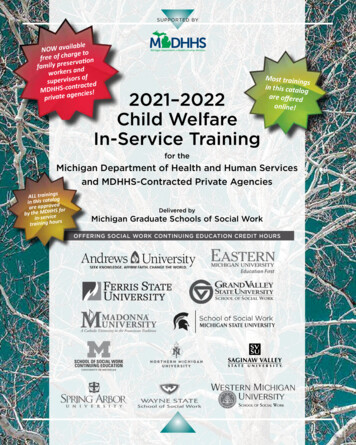
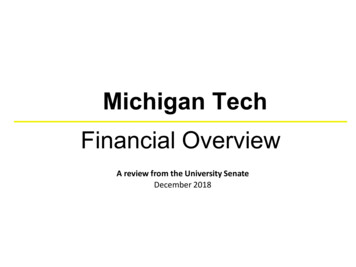
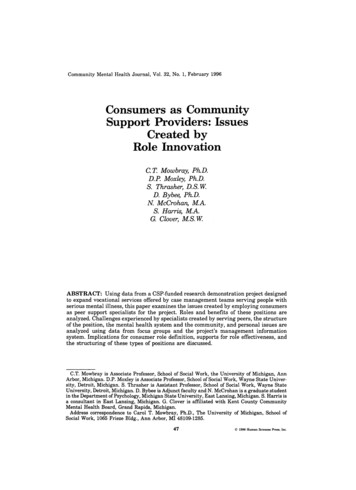
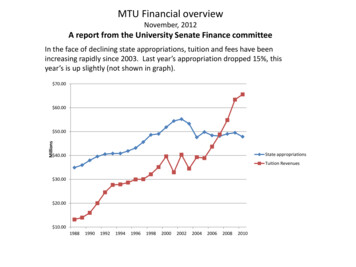

![[Insert Title Here] - ncwwi](/img/21/ncwwi-roles-and-photos-service-recipients-final.jpg)
